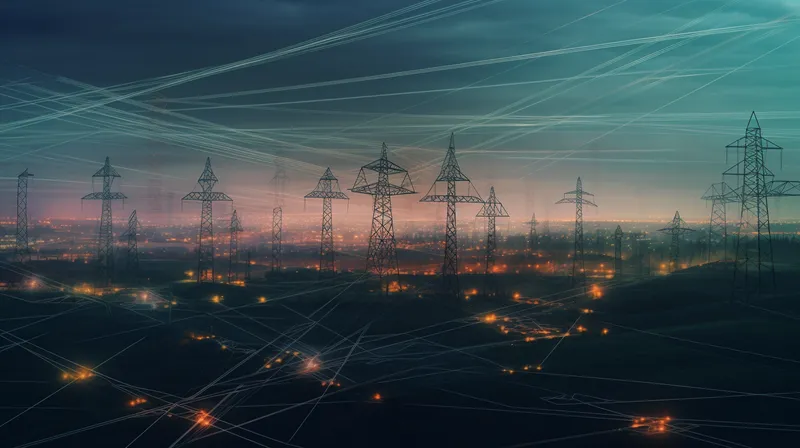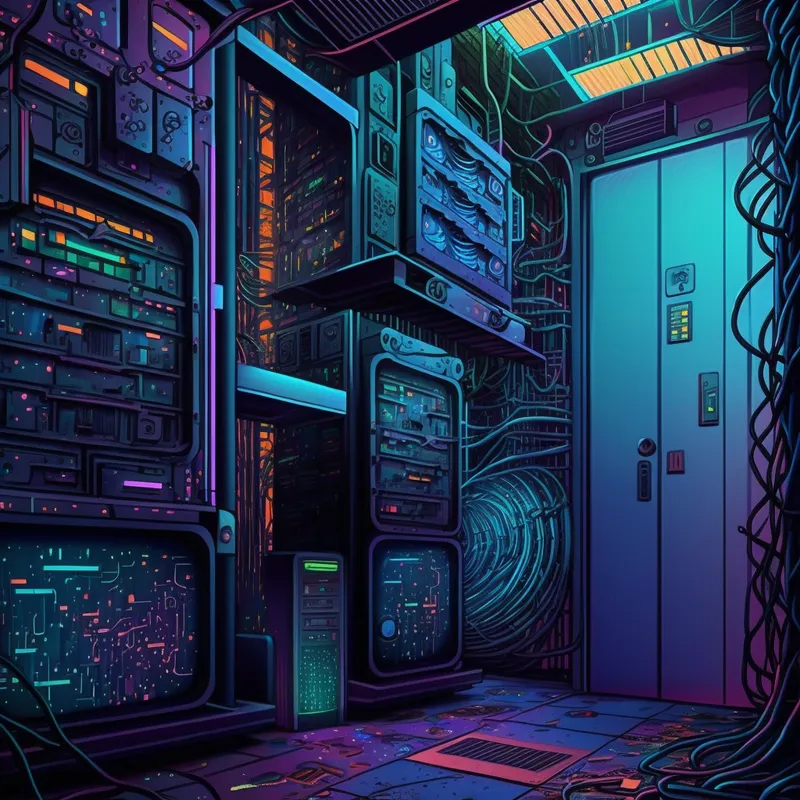Book about cybersecurity and AI in the power sector
Authors: Storm and ChatGPT (using GPT-4)
Table of Contents
Part I: Introduction
- The Importance of Cybersecurity and AI in the Electric Power Sector
- Overview of the Electric Power Sector
- Threat Landscape and Risk Assessment
Part II: Cybersecurity in the Electric Power Sector
- Cybersecurity Frameworks and Best Practices
- Cybersecurity Standards and Regulations in the Electric Power Sector
- Case Studies: Cybersecurity Incidents in the Electric Power Sector
- Cybersecurity Technologies and Tools
Part III: AI in the Electric Power Sector
- Introduction to AI and Machine Learning
- AI Applications in the Electric Power Sector
- AI-enabled Grid Management and Control
- Case Studies: AI Implementation in the Electric Power Sector
- Ethical Considerations in AI Development and Deployment
Part IV: Cybersecurity and AI Integration
- Cybersecurity Challenges and Opportunities for AI in the Electric Power Sector
- AI for Cybersecurity in the Electric Power Sector
- Case Studies: Cybersecurity and AI Integration in the Electric Power Sector
- Future Directions and Emerging Trends
Part V: Conclusion
- Summary and Key Takeaways
- Recommendations for Cybersecurity and AI in the Electric Power Sector
- The Future of Cybersecurity and AI in the Electric Power Sector
Part I: Introduction

This book explores the critical roles of cybersecurity and artificial intelligence (AI) in the electric power sector. It begins with an introduction to the importance of cybersecurity and AI, offering an overview of the electric power sector and discussing the threat landscape and risk assessment.
The second part of the book delves into cybersecurity in the electric power sector, presenting various frameworks, best practices, standards, and regulations. It also includes case studies of cybersecurity incidents to highlight vulnerabilities and potential consequences.
Part III introduces AI and machine learning, discussing their applications in the electric power sector, including AI-enabled grid management and control. It provides case studies of AI implementation and addresses ethical considerations in AI development and deployment.
In Part IV, the book examines the integration of cybersecurity and AI, discussing challenges and opportunities, and how AI can enhance cybersecurity in the electric power sector. This section includes case studies of successful cybersecurity and AI integration, and explores future directions and emerging trends.
Finally, Part V concludes with a summary of key takeaways and recommendations for improving cybersecurity and AI in the electric power sector, as well as a discussion on the future of these technologies. This comprehensive book offers valuable insights for stakeholders in the electric power sector, helping them to better understand and address the critical aspects of cybersecurity and AI.
The Importance of Cybersecurity and AI in the Electric Power Sector

The electric power sector has become increasingly dependent on digital technology and interconnected systems to manage its complex infrastructure. As this reliance grows, so does the importance of robust cybersecurity measures to protect the integrity, availability, and confidentiality of these systems. At the same time, the potential of artificial intelligence (AI) to revolutionize the way the sector operates has become increasingly apparent. This chapter aims to emphasize the importance of both cybersecurity and AI in the electric power sector and demonstrate how they are essential components of its long-term success and resilience.
In recent years, the number of cyber attacks targeting the energy sector has grown significantly, with hackers exploiting vulnerabilities in networks and systems to cause disruptions and financial losses. The power grid's interconnected nature and reliance on automated control systems make it particularly susceptible to cyber threats. These threats not only have the potential to compromise sensitive data but can also lead to widespread power outages, endangering public safety and causing economic harm.
As cyber threats continue to evolve, the need for advanced cybersecurity measures in the electric power sector becomes more crucial. Traditional methods, such as firewalls and intrusion detection systems, are no longer sufficient to counter the sophisticated attacks launched by cybercriminals and nation-state actors. Consequently, utilities and power sector stakeholders must continuously update their security policies, practices, and technologies to stay ahead of potential adversaries.
This is where AI comes into play. AI has the potential to revolutionize various aspects of the electric power sector, from enhancing grid management and control to improving energy efficiency and reducing emissions. By leveraging AI and machine learning algorithms, utilities can analyze vast amounts of data in real-time, enabling them to make smarter decisions and optimize their operations. For instance, AI can be used to predict equipment failures, allowing for preventative maintenance and reducing downtime. Additionally, AI can optimize energy generation and distribution, leading to more efficient and sustainable power systems.
However, the integration of AI into the electric power sector is not without challenges. AI systems themselves may be vulnerable to cyber attacks, which can compromise their integrity and effectiveness. To fully harness the benefits of AI, it is essential to ensure that these systems are secure and resilient against potential threats. This can be achieved by implementing robust cybersecurity measures, such as encryption, secure coding practices, and continuous monitoring of AI systems.
Moreover, the successful integration of AI and cybersecurity in the electric power sector requires the development of a skilled workforce capable of managing and maintaining these technologies. Training and education programs should be established to provide workers with the necessary knowledge and skills to navigate the rapidly evolving landscape of digital technology in the power sector.
In conclusion, the importance of cybersecurity and AI in the electric power sector cannot be overstated. As the sector becomes more reliant on digital systems, the need to protect them from cyber threats and harness the power of AI to improve operations becomes paramount. By investing in robust cybersecurity measures and fostering AI integration, the electric power sector can enhance its resilience, efficiency, and sustainability, ensuring a more secure and reliable energy future for all.
Overview of the Electric Power Sector

The electric power sector is a complex and critical component of modern society, responsible for generating, transmitting, and distributing electricity to residential, commercial, and industrial consumers. This chapter provides an overview of the key elements of the electric power sector, including the generation, transmission, and distribution of electricity, as well as the market structures and regulatory frameworks that govern the industry.
The electric power sector is composed of several interconnected segments: generation, transmission, distribution, and end-users. Electricity generation involves the production of electricity from various energy sources, such as fossil fuels (coal, natural gas, and oil), nuclear power, and renewable energy sources (solar, wind, hydroelectric, and geothermal). The electricity produced by these sources is then fed into the power grid.
Transmission is the next stage in the electric power sector, which involves transporting high-voltage electricity from power plants to substations through a network of transmission lines. High voltage is used to minimize energy losses during transportation. Substations then transform the high-voltage electricity into lower voltages suitable for distribution to end-users.
The distribution segment of the electric power sector comprises a network of lower-voltage power lines, transformers, and other equipment that deliver electricity from substations to homes, businesses, and industrial facilities. Distribution utilities maintain these systems and are responsible for ensuring the reliable delivery of electricity to consumers.
Electricity markets are designed to facilitate the buying and selling of electricity among generators, utilities, and other market participants. These markets can be structured in various ways, ranging from vertically integrated utilities, where a single entity is responsible for generation, transmission, and distribution, to more competitive markets, which encourage competition among electricity providers. Market structures and regulations are typically determined by national or regional governments, and their design can significantly impact the efficiency and reliability of the electric power sector.
The electric power sector is subject to numerous regulations and standards aimed at ensuring the safe, reliable, and sustainable operation of the power grid. These regulations may address issues such as environmental protection, grid reliability, cybersecurity, and consumer protection. In many countries, independent regulatory bodies are responsible for overseeing the electric power sector and enforcing compliance with relevant regulations and standards.
Technological advancements, such as smart grid technologies and the increasing deployment of renewable energy sources, have introduced new challenges and opportunities for the electric power sector. Smart grids utilize advanced sensors, communication networks, and data analytics to optimize the generation, transmission, and distribution of electricity. These technologies can enhance grid efficiency and resilience while facilitating the integration of distributed energy resources, such as rooftop solar panels and battery storage systems.
In summary, the electric power sector is a complex and vital industry that plays a crucial role in modern society. By understanding the key components of this sector, including electricity generation, transmission, distribution, and market structures, stakeholders can better appreciate the challenges and opportunities associated with ensuring the reliable and sustainable supply of electricity in the face of evolving technologies and emerging threats, such as cybersecurity risks and the need for AI integration.
Threat Landscape and Risk Assessment

"As the digital revolution continues to transform the electric power sector, we must remain vigilant against the ever-evolving cyber threat landscape that seeks to exploit our vulnerabilities." – Dr. Jane L. Edison, Cybersecurity Expert
The electric power sector is facing an increasingly complex and dynamic cyber threat landscape. This chapter aims to provide an overview of the various threats and risks associated with the digitalization of the electric power sector, as well as the importance of conducting regular risk assessments to identify and address potential vulnerabilities.
Cyber threats in the electric power sector can originate from various sources, including nation-state actors, cybercriminals, hacktivists, and insider threats. These adversaries may have different motivations, such as financial gain, espionage, sabotage, or political activism, but their actions can have severe consequences for the stability and reliability of the power grid.
Some common types of cyber threats in the electric power sector include:
-
Phishing attacks: These attacks use deceptive emails or messages to trick individuals into revealing sensitive information or granting unauthorized access to systems. Phishing attacks can target utility employees, contractors, or third-party vendors with access to critical infrastructure.
-
Advanced Persistent Threats (APTs): APTs are sophisticated, long-term cyber-espionage campaigns, often attributed to nation-state actors, that seek to infiltrate and compromise target networks and systems. A successful APT can give adversaries extensive access to sensitive data and control over critical infrastructure.
-
Ransomware: Ransomware is a type of malware that encrypts a victim's data and demands payment in exchange for the decryption key. Ransomware attacks can cripple utility operations, disrupt critical services, and cause significant financial losses.
-
Distributed Denial of Service (DDoS) attacks: DDoS attacks involve overwhelming a target's network or systems with a flood of malicious traffic, rendering them unable to function. DDoS attacks can disrupt utility communications and control systems, leading to operational instability and potential outages.
To protect against these threats, utilities and power sector stakeholders must adopt a proactive approach to risk assessment and mitigation. This involves regularly evaluating the cyber risks associated with their systems, processes, and supply chain, and implementing appropriate security measures to address identified vulnerabilities. Key elements of a robust risk assessment process include:
- Identifying critical assets and potential threats
- Evaluating the likelihood and impact of potential threats
- Prioritizing risks based on their potential consequences
- Implementing appropriate security controls and mitigation strategies
- Continuously monitoring and updating risk assessments to reflect changes in the threat landscape
In conclusion, understanding the threat landscape and conducting regular risk assessments are essential steps in securing the electric power sector against the increasing cyber risks associated with digitalization. By adopting a proactive approach to risk management, utilities and power sector stakeholders can minimize the potential consequences of cyber attacks and enhance the resilience of the power grid.
Part II: Cybersecurity in the Electric Power Sector
Cybersecurity Frameworks and Best Practices

"Success in securing the electric power sector requires a systematic approach that incorporates best practices and leverages established cybersecurity frameworks." – NIST Cybersecurity Framework
The electric power sector faces unique challenges in securing its critical infrastructure due to the increasing interconnectedness of its systems and the growing sophistication of cyber threats. Adopting comprehensive cybersecurity frameworks and adhering to best practices can help utilities and power sector stakeholders develop and maintain a robust security posture. This chapter outlines various cybersecurity frameworks and best practices that can be applied to the electric power sector.
Several cybersecurity frameworks have been developed to provide organizations with a structured approach to managing their cybersecurity risks. These frameworks offer guidance on the implementation of security controls and the development of policies and procedures to ensure the confidentiality, integrity, and availability of critical systems and data. Some widely-recognized cybersecurity frameworks include:
-
NIST Cybersecurity Framework: Developed by the US National Institute of Standards and Technology (NIST), this voluntary framework provides a set of guidelines and best practices for organizations to manage and reduce their cybersecurity risks. It is organized into five core functions: Identify, Protect, Detect, Respond, and Recover.
-
ISO/IEC 27001: This international standard, published by the International Organization for Standardization (ISO) and the International Electrotechnical Commission (IEC), provides a systematic approach to managing information security risks through the implementation of an Information Security Management System (ISMS). It includes a comprehensive set of security controls covering various aspects of information security.
-
NERC CIP: The North American Electric Reliability Corporation's (NERC) Critical Infrastructure Protection (CIP) standards are a set of mandatory cybersecurity requirements for the electric power sector in North America. These standards aim to enhance the security of the bulk electric system by establishing baseline requirements for the protection of critical assets and cyber systems.
Implementing a cybersecurity framework involves several key steps, such as conducting risk assessments, selecting appropriate security controls, developing policies and procedures, and continuously monitoring and improving the organization's security posture. This process should be tailored to the unique requirements and risks of the electric power sector, taking into account the specific operational and regulatory environments in which utilities operate.
In addition to adopting cybersecurity frameworks, utilities and power sector stakeholders should adhere to industry best practices to strengthen their cybersecurity posture further. Some best practices include:
- Implementing a defense-in-depth strategy, which involves deploying multiple layers of security controls to protect critical assets and systems from various attack vectors.
- Ensuring strong access controls and authentication mechanisms, such as multi-factor authentication, to prevent unauthorized access to systems and data.
- Regularly updating and patching software and hardware to address known vulnerabilities and minimize the risk of exploitation.
- Conducting regular security awareness training for employees to help them recognize and respond to potential cyber threats.
- Establishing a robust incident response plan to facilitate a rapid and effective response to security incidents, minimizing potential damage and downtime.
In conclusion, leveraging established cybersecurity frameworks and adhering to industry best practices can significantly enhance the security posture of the electric power sector. By adopting a systematic and comprehensive approach to cybersecurity, utilities and power sector stakeholders can better protect their critical infrastructure from the growing and evolving cyber threats that they face.
Cybersecurity Standards and Regulations in the Electric Power Sector

"The only truly secure system is one that is powered off, cast in a block of concrete and sealed in a lead-lined room with armed guards." – Gene Spafford, Computer Scientist and Cybersecurity Expert
While Spafford's quote is a humorous exaggeration, it highlights the inherent challenges of ensuring cybersecurity in the electric power sector. This critical infrastructure must be safeguarded from a wide range of cyber threats, requiring utilities and power sector stakeholders to comply with various cybersecurity standards and regulations. This chapter provides an overview of the key cybersecurity standards and regulations that govern the electric power sector and the importance of compliance to ensure the security and resilience of the power grid.
Several regulatory bodies and standards organizations have developed cybersecurity requirements specifically tailored to the electric power sector. These requirements aim to address the unique challenges and risks associated with securing critical infrastructure, such as the power grid, and ensure the reliable delivery of electricity to consumers. Some of the most prominent cybersecurity standards and regulations in the electric power sector include:
-
NERC CIP: As mentioned in Chapter 4, the North American Electric Reliability Corporation's (NERC) Critical Infrastructure Protection (CIP) standards are a set of mandatory cybersecurity requirements for the electric power sector in North America. These standards address various aspects of cybersecurity, such as access control, physical security, incident reporting, and system security management. Non-compliance with NERC CIP standards can result in significant financial penalties.
-
FERC Order 841: Issued by the US Federal Energy Regulatory Commission (FERC), Order 841 requires regional transmission organizations (RTOs) and independent system operators (ISOs) to establish market rules that accommodate the participation of electric storage resources in wholesale electricity markets. This order also addresses cybersecurity concerns related to the integration of these resources into the power grid.
-
EU Network and Information Systems (NIS) Directive: The NIS Directive is the first EU-wide legislation on cybersecurity, focusing on the protection of critical infrastructure, including the electric power sector. Under the NIS Directive, EU member states are required to identify operators of essential services (OES) and establish national strategies to ensure their security. OES, such as electric utilities, are required to take appropriate security measures and report significant incidents to national authorities.
-
IEC 62443: Developed by the International Electrotechnical Commission (IEC), the IEC 62443 series of standards provide a comprehensive framework for securing industrial automation and control systems (IACS), including those used in the electric power sector. These standards address various aspects of IACS cybersecurity, such as risk management, system design, and secure development practices.
Compliance with these standards and regulations is essential for ensuring the security and resilience of the electric power sector. However, compliance alone does not guarantee a robust security posture. Utilities and power sector stakeholders must also adopt best practices, invest in continuous improvement, and foster a culture of security awareness throughout their organizations.
It is important to note that regulations and standards may vary by jurisdiction, and utilities may be subject to additional requirements at the regional or national level. Therefore, it is crucial for utilities and power sector stakeholders to stay informed about the regulatory landscape in their respective jurisdictions and ensure compliance with all applicable cybersecurity standards and regulations.
In conclusion, adhering to cybersecurity standards and regulations is a critical component of securing the electric power sector. By complying with these requirements and adopting best practices, utilities and power sector stakeholders can significantly enhance the security and resilience of their critical infrastructure, protecting against the ever-evolving cyber threat landscape.
Case Studies: Cybersecurity Incidents in the Electric Power Sector

In this chapter, we will explore three case studies that illustrate the cybersecurity challenges faced by the electric power sector and the potential consequences of successful cyber attacks.
Case Study 1: Ukrainian Power Grid Attack (2015)
In December 2015, a cyber attack on Ukraine's power grid left approximately 230,000 residents without electricity for several hours. The attackers, believed to be state-sponsored, used spear-phishing emails to gain access to the networks of three regional power distribution companies. They then deployed malware called BlackEnergy to disrupt the utilities' systems and launched a coordinated telephony denial of service (TDoS) attack to prevent customers from reporting the outage. This incident marked the first known cyber attack on a nation's power grid and highlighted the potential for state-sponsored adversaries to target critical infrastructure.
Case Study 2: Dragonfly 2.0 Campaign (2017)
The Dragonfly 2.0 campaign, attributed to a nation-state actor, targeted energy companies in the United States and Europe from 2017 onwards. The attackers used various techniques, including spear-phishing emails, watering hole attacks, and trojanized software, to infiltrate the networks of energy companies and gain access to critical operational systems. The campaign raised concerns about the potential for cyber espionage or sabotage, as the attackers appeared to be gathering intelligence on the functioning of energy sector infrastructure and had the capability to disrupt or damage physical systems.
Case Study 3: EKANS Ransomware (2020)
In 2020, a new strain of ransomware called EKANS (SNAKE spelled backward) specifically targeted industrial control systems (ICS) used in the electric power sector and other critical infrastructure. EKANS encrypted essential data and halted ICS processes, demanding ransom payments in exchange for decryption keys. Notably, EKANS included functionality to terminate specific ICS-related processes, indicating that the attackers had a detailed understanding of the systems they targeted. This ransomware campaign demonstrated the growing sophistication of cybercriminals targeting the electric power sector and the potential for ransomware attacks to disrupt critical services.
Cybersecurity Technologies and Tools

To effectively defend against the growing and evolving cyber threats targeting the electric power sector, utilities and power sector stakeholders must adopt a wide range of cybersecurity technologies and tools. This chapter provides an overview of some key technologies and tools that can be employed to enhance the security and resilience of the electric power sector.
Firewalls: Firewalls are a fundamental component of network security, acting as a barrier between internal and external networks. They monitor and control incoming and outgoing network traffic based on predefined security rules, preventing unauthorized access and protecting critical assets.
Intrusion Detection and Prevention Systems (IDPS): IDPS solutions monitor network traffic for signs of malicious activity and can automatically block or alert security personnel to potential threats. These systems use various techniques, including signature-based detection, anomaly detection, and behavior analysis, to identify and respond to cyber threats.
Endpoint Protection Platforms (EPP): EPP solutions protect endpoint devices, such as workstations, servers, and mobile devices, from malware and other cyber threats. They typically include antivirus, anti-malware, and personal firewall functionality, as well as advanced features like application control, exploit prevention, and endpoint detection and response (EDR) capabilities.
Security Information and Event Management (SIEM): SIEM systems collect and analyze log data from various sources, such as network devices, security systems, and applications, to identify potential security incidents and provide real-time alerts. They also support incident investigation and response by providing security teams with valuable context and insights into security events.
Encryption: Encryption technologies protect the confidentiality and integrity of data, both in transit and at rest, by rendering it unreadable without the appropriate decryption key. Encryption is particularly important for securing sensitive data, such as customer information and control system communications, against unauthorized access and tampering.
Identity and Access Management (IAM): IAM solutions enable organizations to manage and control access to critical systems and data by ensuring that only authorized users can access specific resources. They typically include features such as authentication, authorization, and auditing, as well as user provisioning and deprovisioning capabilities.
Short Story: Practical Use of Cybersecurity Technologies and Tools
GreenLight Energy, a medium-sized electric utility, had been increasingly concerned about the growing cyber threats targeting the electric power sector. To bolster their defenses, they decided to implement a comprehensive set of cybersecurity technologies and tools, including firewalls, IDPS, EPP, SIEM, encryption, and IAM.
One day, GreenLight Energy's security team received an alert from their SIEM system, indicating that an unauthorized user had gained access to a critical control system. The team quickly launched an investigation and discovered that the attacker had exploited a previously unknown vulnerability in a third-party software application.
Thanks to the rapid detection and response capabilities provided by their cybersecurity tools, GreenLight Energy's security team was able to contain the breach and prevent any disruption to their operations. They also shared information about the vulnerability with the software vendor and other utilities, helping to protect the wider electric power sector from similar attacks.
In conclusion, adopting a diverse array of cybersecurity technologies and tools is essential for protecting the electric power sector from the myriad of cyber threats that it faces. By leveraging these technologies and tools, utilities and power sector stakeholders can enhance their security posture and ensure the reliable delivery of electricity to consumers.
Part III: AI in the Electric Power Sector
Introduction to AI and Machine Learning

"The question of whether a computer can think is no more interesting than the question of whether a submarine can swim." – Edsger W. Dijkstra, Computer Scientist
Dijkstra's quote highlights the importance of understanding the capabilities and limitations of artificial intelligence (AI) and machine learning (ML) as they relate to the electric power sector. As these technologies continue to advance, they have the potential to revolutionize various aspects of the industry, from grid management and control to cybersecurity. This chapter provides an introduction to AI and ML, laying the foundation for exploring their applications in the electric power sector.
Artificial intelligence is the broader concept of creating machines and systems that can perform tasks that would typically require human intelligence. These tasks include problem-solving, pattern recognition, learning, and decision-making. Machine learning is a subset of AI that involves the development of algorithms and models that can learn from data, enabling machines to improve their performance on a specific task over time.
There are several types of machine learning, including:
-
Supervised learning: In supervised learning, algorithms are trained on labeled data, where the input-output relationship is known. The goal is to learn a mapping from inputs to outputs that can be generalized to make predictions on new, unseen data.
-
Unsupervised learning: Unsupervised learning algorithms work with unlabeled data, discovering hidden patterns or structures within the data without any prior knowledge of the input-output relationship. Common unsupervised learning techniques include clustering and dimensionality reduction.
-
Reinforcement learning: Reinforcement learning involves training algorithms to make decisions based on feedback from their environment. The algorithm learns to optimize its actions by maximizing a reward signal, which is received for each successful action taken.
Deep learning, another subset of machine learning, has gained significant attention in recent years. Deep learning algorithms use artificial neural networks with multiple layers to model complex relationships between inputs and outputs. These networks can learn hierarchical representations of data, enabling them to tackle problems that traditional machine learning methods may struggle with, such as image and speech recognition.
AI and ML technologies hold significant promise for the electric power sector, offering the potential to optimize grid management, enhance situational awareness, and improve cybersecurity, among other applications. However, it is crucial to recognize the limitations and challenges associated with these technologies, such as data quality, privacy concerns, and the risk of bias in algorithmic decision-making.
In the following chapters, we will explore the applications of AI and ML in the electric power sector, discussing their potential benefits and challenges, and examining real-world case studies of their implementation. By understanding the capabilities and limitations of AI and ML, utilities and power sector stakeholders can make informed decisions about adopting these technologies to enhance the efficiency, reliability, and security of the power grid.
AI Applications in the Electric Power Sector

"AI is a tool. The choice about how it gets deployed is ours." – Oren Etzioni, CEO of Allen Institute for Artificial Intelligence
Etzioni's quote emphasizes that AI is a powerful tool, and its deployment in various industries, including the electric power sector, depends on how we choose to utilize it. This chapter explores the various applications of AI and machine learning in the electric power sector, highlighting the potential benefits, challenges, and real-world examples.
-
Grid optimization and demand forecasting: AI can help optimize grid operations by predicting electricity demand and generation more accurately. By analyzing historical data and incorporating factors such as weather patterns, economic indicators, and consumer behavior, AI-powered models can enable utilities to make better-informed decisions about power generation, distribution, and storage.
-
Renewable energy integration: The integration of renewable energy sources, such as solar and wind, poses challenges due to their intermittent and variable nature. AI and machine learning can help manage these resources more effectively by predicting generation patterns, optimizing energy storage, and facilitating real-time grid adjustments.
-
Asset management and predictive maintenance: AI can be used to monitor the health of power grid assets, such as transformers, substations, and transmission lines, by analyzing sensor data and detecting anomalies. Predictive maintenance algorithms can help identify potential issues before they lead to equipment failure or outages, minimizing downtime and reducing maintenance costs.
-
Energy efficiency and demand response: AI can help improve energy efficiency by identifying patterns in energy consumption data and providing recommendations for optimization. Additionally, AI-driven demand response programs can use real-time data to incentivize customers to reduce energy usage during peak demand periods, contributing to grid stability and lowering energy costs.
-
Outage management and restoration: AI can help utilities quickly identify the root causes of outages, prioritize restoration efforts, and minimize downtime. Machine learning algorithms can analyze data from sensors, social media, and customer reports to provide real-time insights into the extent and impact of outages, enabling utilities to respond more effectively.
-
Cybersecurity: As discussed in Chapter 14, AI can play a critical role in enhancing cybersecurity in the electric power sector. Machine learning algorithms can be employed to detect and respond to cyber threats more effectively, protecting critical infrastructure and ensuring the reliable delivery of electricity.
While AI and machine learning offer significant potential for improving the electric power sector's efficiency, reliability, and security, it is crucial to recognize the associated challenges, such as data privacy concerns, algorithmic bias, and the need for skilled personnel to develop and manage AI systems. By addressing these challenges and responsibly deploying AI, utilities and power sector stakeholders can harness the full potential of these technologies to transform the industry and better serve their customers.
AI-enabled Grid Management and Control

"I am here to optimize, secure, and protect the energy that powers our world." – GRID-1, AI-Powered Grid Management System
This fictional quote from GRID-1, an AI-powered grid management system, demonstrates the potential for artificial intelligence to revolutionize the way we manage and control the electric power grid. In this chapter, we will explore the various ways in which AI can be leveraged to enable more efficient, reliable, and secure grid management and control.
-
Dynamic grid management: AI can be used to monitor and control the power grid in real-time, responding to changes in demand, supply, and grid conditions. By processing vast amounts of data from sensors and other sources, AI algorithms can quickly identify and resolve potential issues, optimize power flow, and maintain grid stability.
-
Distributed energy resource (DER) management: The increasing adoption of distributed energy resources, such as solar panels and energy storage systems, poses new challenges for grid management. AI can help utilities manage these resources more effectively by aggregating and controlling them as virtual power plants, ensuring optimal utilization of clean energy while maintaining grid stability.
-
Automated demand response: AI-driven demand response programs can use real-time data to incentivize customers to reduce energy usage during peak demand periods. By predicting and managing peak demand, AI can help utilities avoid the need for costly infrastructure upgrades and reduce reliance on fossil-fuel-based peaking power plants.
-
Resilience and emergency response: AI can enhance grid resilience by identifying vulnerabilities, simulating potential disruptions, and recommending mitigation strategies. In the event of an emergency, AI can help utilities prioritize restoration efforts, minimize downtime, and coordinate resources more effectively.
-
Advanced metering infrastructure (AMI) analysis: AI can help utilities derive valuable insights from the vast amounts of data generated by advanced metering infrastructure. By analyzing patterns in energy consumption, AI can identify opportunities for energy efficiency improvements, detect energy theft, and enable more accurate billing and demand forecasting.
-
Grid-edge intelligence: AI can be employed at the edge of the grid, leveraging local data and computing resources to enable real-time decision-making and control. Grid-edge intelligence can help manage distributed energy resources, enhance grid resilience, and enable the development of new energy services and business models.
AI-enabled grid management and control offers significant potential benefits for the electric power sector. However, it is essential to recognize the challenges and risks associated with the widespread adoption of AI, such as data privacy concerns, cybersecurity threats, and the need for a skilled workforce to develop, deploy, and maintain AI systems. By addressing these challenges and embracing the opportunities presented by AI, utilities and power sector stakeholders can revolutionize grid management and control, ensuring a more sustainable, resilient, and secure energy future.
Case Studies: AI Implementation in the Electric Power Sector

"Disse må da være funnet på." - Jon-Martin Storm
In this chapter, we will explore two real-world case studies that demonstrate the successful implementation of AI and machine learning technologies in the electric power sector, highlighting the potential benefits and challenges associated with these applications.
Case Study 1: Solar Forecasting for a Utility Company
A utility company operating in a region with a high penetration of solar power faced challenges in integrating the intermittent and variable generation from solar resources. Accurate solar forecasting was crucial for efficient grid management and ensuring a reliable power supply.
The utility company partnered with an AI solutions provider to develop a machine learning model that could predict solar generation more accurately. The model was trained using historical solar generation data, weather forecasts, and satellite imagery. The AI-driven solar forecasting system significantly improved the accuracy of solar generation predictions, enabling the utility to optimize grid operations, reduce the reliance on backup power sources, and lower operational costs.
This case study demonstrates the potential of AI and machine learning to enhance the integration of renewable energy resources and improve the efficiency and reliability of the electric power grid.
Case Study 2: Predictive Maintenance for a Power Plant
A large power plant faced significant maintenance costs and unplanned downtime due to equipment failures, impacting the plant's overall efficiency and reliability. To address this issue, the plant operators decided to implement an AI-driven predictive maintenance solution.
The solution involved the installation of sensors on critical equipment, such as turbines, generators, and transformers, to collect real-time performance data. A machine learning algorithm was then developed to analyze the sensor data, identify patterns indicative of potential equipment failure, and provide early warnings of impending issues.
The implementation of the predictive maintenance solution led to a significant reduction in unplanned downtime and maintenance costs, as well as improved operational efficiency and equipment lifespan. By proactively addressing potential issues, the power plant was able to optimize its maintenance processes and enhance overall reliability.
This case study highlights the potential of AI and machine learning technologies to revolutionize asset management and maintenance in the electric power sector, ultimately improving efficiency, reliability, and cost-effectiveness.
These case studies illustrate the transformative potential of AI and machine learning in the electric power sector. By harnessing the power of these technologies, utilities and power sector stakeholders can enhance the efficiency, reliability, and security of the grid, ensuring a more sustainable and resilient energy future. However, it is crucial to recognize the challenges associated with implementing AI, such as data quality, privacy concerns, and the need for skilled personnel, and to address these issues proactively to ensure the successful adoption of AI-driven solutions.
Ethical Considerations in AI Development and Deployment

Utility Manager: "Our new AI system has significantly improved grid management and control, but I'm concerned about the ethical implications of using AI in the electric power sector."
AI Ethics Expert: "That's a valid concern. As AI becomes more prevalent in the industry, it's crucial to address the ethical challenges associated with its development and deployment."
The conversation above highlights the increasing awareness of ethical considerations in AI development and deployment within the electric power sector. As AI and machine learning technologies become more integrated into the industry, it is essential to address these ethical challenges to ensure responsible and equitable AI adoption. In this chapter, we will discuss some of the key ethical concerns related to AI in the electric power sector and provide guidance on addressing them.
-
Data privacy: AI and machine learning algorithms rely on vast amounts of data to learn and make predictions. In the electric power sector, this data often includes sensitive information about customers and grid infrastructure. It is crucial to protect this data and ensure that privacy rights are respected. Utilities and AI developers should adhere to data protection regulations, employ secure data storage and transmission methods, and anonymize data when possible.
-
Algorithmic bias and fairness: AI algorithms can inadvertently perpetuate and amplify biases present in the data used for training. This can lead to unfair outcomes for certain groups of customers or disproportionately affect specific regions. To mitigate these risks, it is essential to ensure diversity in the data used for training and to assess and monitor algorithmic fairness regularly.
-
Transparency and explainability: As AI systems become more complex, understanding their decision-making processes can become increasingly challenging. Transparent and explainable AI is essential for building trust among stakeholders and ensuring that AI-driven decisions can be held accountable. AI developers should strive to create models that are interpretable and provide clear explanations for their outputs.
-
Security and safety: The integration of AI into the electric power sector raises concerns about the security and safety of critical infrastructure. Ensuring the robustness of AI systems against cyberattacks and adversarial inputs is vital to maintain grid stability and protect sensitive data. Utilities and AI developers should prioritize security and safety in the design, development, and deployment of AI systems.
-
Workforce implications: The widespread adoption of AI in the electric power sector may lead to job displacement and require a shift in workforce skills. It is essential to consider the potential impacts on the workforce and provide support for reskilling and upskilling programs, ensuring a just transition for affected workers.
-
Environmental impact: While AI has the potential to improve energy efficiency and facilitate the integration of renewable energy sources, the development and deployment of AI systems can also consume significant amounts of energy and contribute to electronic waste. Utilities and AI developers should consider the environmental impact of AI technologies and strive to minimize their footprint.
Addressing these ethical considerations is critical to ensuring the responsible and equitable adoption of AI in the electric power sector. By actively engaging with these challenges and promoting a culture of ethical AI development and deployment, utilities and power sector stakeholders can harness the full potential of AI while protecting the interests of customers, employees, and the environment.
Part IV: Cybersecurity and AI Integration
Cybersecurity Challenges and Opportunities for AI in the Electric Power Sector

"Artificial intelligence can be both a sword and a shield for cybersecurity. It depends on how we wield it." – Anonymous Cybersecurity Expert
The quote above emphasizes that AI holds immense potential to improve cybersecurity in the electric power sector, but it also presents new challenges that need to be addressed. This chapter will explore the various cybersecurity challenges and opportunities associated with AI in the electric power sector, providing insights and recommendations for navigating this complex landscape.
Cybersecurity Challenges for AI in the Electric Power Sector:
-
AI-powered cyberattacks: As AI technologies become more advanced, cybercriminals are increasingly leveraging AI capabilities to develop sophisticated attacks targeting the electric power sector. AI-driven malware, ransomware, and phishing campaigns can adapt and evolve to bypass traditional security defenses, making them more challenging to detect and mitigate.
-
Adversarial machine learning: Adversarial machine learning is a technique used by attackers to manipulate AI models by introducing malicious inputs or altering the training data. In the electric power sector, these attacks could compromise AI-driven grid management systems, leading to incorrect predictions, decision-making errors, or even severe disruptions to grid operations.
-
Data privacy and integrity: AI systems in the electric power sector rely on vast amounts of data, which may include sensitive information about customers and critical infrastructure. Protecting this data from unauthorized access, theft, or tampering is crucial to maintain the confidentiality, integrity, and availability of AI-driven systems and services.
-
Supply chain security: AI technologies often rely on components, software, and services from a variety of vendors, introducing potential vulnerabilities through the supply chain. Ensuring the security of these components and addressing potential risks is essential to maintain the trustworthiness of AI systems in the electric power sector.
Opportunities for AI in Enhancing Cybersecurity in the Electric Power Sector:
-
Anomaly detection and threat hunting: AI and machine learning can be employed to analyze vast amounts of data from various sources, such as network traffic, log files, and sensor data, to identify unusual patterns or behaviors that may indicate a cyber threat. This enables utilities to detect and respond to potential security incidents more effectively and proactively.
-
Automated incident response: AI can help automate and streamline the incident response process by prioritizing alerts, providing real-time insights into the scope and impact of security incidents, and recommending appropriate mitigation strategies. This can significantly reduce the time it takes for utilities to contain and remediate cyber threats.
-
Security analytics and intelligence: AI-driven security analytics can help utilities gain a deeper understanding of the ever-evolving threat landscape by correlating data from multiple sources and identifying emerging trends, tactics, and vulnerabilities. This intelligence can inform the development of more effective security strategies, policies, and technologies.
-
User and entity behavior analytics (UEBA): AI can be used to develop profiles of normal user and system behavior, enabling utilities to identify deviations that may indicate a potential security risk. UEBA can help detect insider threats, compromised credentials, and other hard-to-detect security issues.
To capitalize on the opportunities presented by AI for enhancing cybersecurity in the electric power sector, it is crucial to address the associated challenges and risks proactively. This requires a comprehensive, risk-based approach to security that integrates AI-driven technologies and solutions with robust policies, processes, and human expertise. By embracing the potential of AI while remaining vigilant to its challenges, utilities and power sector stakeholders can bolster their cybersecurity posture and protect the critical infrastructure that powers our modern world.
AI for Cybersecurity in the Electric Power Sector

"AI is like a guardian angel for the electric power grid, tirelessly watching, learning, and protecting." – Cybersecurity Innovator
import ai_defense
ai_defense.train_model(training_data)
ai_defense.deploy(model)
The quote and lines of code above symbolize the potential for AI to revolutionize cybersecurity in the electric power sector. In this chapter, we will delve into specific AI-driven technologies and approaches that can be employed to enhance cybersecurity in the electric power industry.
-
Intrusion Detection and Prevention Systems (IDPS): AI-enhanced IDPS can analyze network traffic patterns and identify potential threats by learning from historical data and adapting to new attack vectors. These intelligent systems can detect and block threats in real-time, protecting the grid from cyber intrusions.
-
Phishing Detection and Email Filtering: AI-powered email filters can analyze the content and context of emails, detecting and flagging phishing attempts targeting utility employees. By preventing these malicious emails from reaching inboxes, AI can help reduce the risk of successful phishing attacks, which often serve as entry points for more advanced threats.
-
Malware Analysis and Detection: AI-driven malware analysis tools can quickly and accurately identify new malware variants by analyzing their behavior, code patterns, and other characteristics. These tools can help utilities stay ahead of emerging threats and reduce the risk of malware infections.
-
Vulnerability Management: AI can help utilities identify and prioritize vulnerabilities in their infrastructure by analyzing large volumes of vulnerability data, considering factors such as the potential impact, exploitability, and historical trends. This enables utilities to focus their remediation efforts on the most critical and relevant risks.
-
Secure AI Development and Deployment: AI systems in the electric power sector must be designed with security in mind, incorporating best practices for secure development and deployment, such as robust input validation, secure coding practices, and thorough testing. AI-driven tools can assist in identifying and mitigating potential security vulnerabilities during the development process.
-
Security Awareness Training: AI can be utilized to develop personalized and adaptive security awareness training programs for utility employees, using gamification, real-time feedback, and advanced analytics to enhance engagement and learning outcomes. By equipping employees with the knowledge and skills to recognize and respond to cyber threats, utilities can build a strong human firewall.
-
Threat Intelligence and Information Sharing: AI can facilitate the automated sharing and analysis of threat intelligence among utilities and other stakeholders, helping the industry stay informed about the latest threats and vulnerabilities. This collaborative approach can contribute to the collective defense of the electric power sector and enhance overall cybersecurity resilience.
By integrating AI-driven technologies and approaches into their cybersecurity strategies, utilities can strengthen their defenses against the ever-evolving cyber threat landscape. However, it is crucial to acknowledge that AI is not a panacea for cybersecurity challenges and must be combined with robust policies, processes, and human expertise to achieve the desired outcomes. By embracing the potential of AI while remaining vigilant to its limitations and risks, utilities and power sector stakeholders can create a more secure and resilient energy infrastructure for the future.
Case Studies: Cybersecurity and AI Integration in the Electric Power Sector

"Integrating AI with cybersecurity in the electric power sector is like weaving a safety net that grows stronger with each stitch." – Power Grid Security Expert
This chapter will present three case studies that showcase the successful integration of AI and cybersecurity in the electric power sector, highlighting the benefits and lessons learned from these real-world applications.
Case Study 1: AI-driven Intrusion Detection and Prevention for a National Grid Operator
A national grid operator faced increasing cyber threats targeting its critical infrastructure. To bolster its defenses, the operator implemented an AI-driven intrusion detection and prevention system (IDPS) that continuously analyzed network traffic patterns and identified potential threats in real-time.
The AI-enhanced IDPS proved highly effective in detecting and blocking cyber intrusions, significantly improving the grid operator's cybersecurity posture. By leveraging AI's adaptive capabilities, the system could quickly learn from new attack vectors and evolve its defenses accordingly.
Case Study 2: Enhancing Security Awareness Training with AI at a Utility Company
A utility company recognized the importance of its employees in maintaining strong cybersecurity defenses. To enhance its security awareness training program, the company integrated AI to create personalized, adaptive learning experiences for its employees, incorporating gamification and real-time feedback.
The AI-powered training program led to higher employee engagement and improved retention of cybersecurity best practices. As a result, the utility company experienced a significant reduction in security incidents attributed to human error, demonstrating the value of investing in employee training and leveraging AI to optimize learning outcomes.
Case Study 3: AI-assisted Vulnerability Management at a Power Plant
A power plant sought to optimize its vulnerability management processes to focus on the most critical risks to its operations. The plant implemented an AI-driven vulnerability management solution that analyzed large volumes of vulnerability data and prioritized remediation efforts based on factors such as potential impact, exploitability, and historical trends.
The AI-assisted vulnerability management approach enabled the power plant to allocate its resources more effectively, addressing the most urgent risks and enhancing the overall security of its infrastructure. The plant also benefited from the AI system's ability to learn from new vulnerability data, continuously refining its prioritization criteria and ensuring that resources were directed toward the most relevant threats.
These case studies illustrate the transformative potential of integrating AI and cybersecurity in the electric power sector. By harnessing the power of AI-driven technologies and approaches, utilities and power sector stakeholders can enhance their cybersecurity defenses and protect the critical infrastructure that underpins our modern world. However, it is essential to recognize the challenges associated with AI integration, such as data privacy concerns, algorithmic bias, and the need for skilled personnel, and to address these issues proactively to ensure the successful adoption of AI-driven cybersecurity solutions.
Future Directions and Emerging Trends

"In the future, AI and cybersecurity will dance a delicate tango, each leading and following in perfect harmony." – Anonymous Futurist
The peculiar quote above captures the intricate and dynamic relationship between AI and cybersecurity in the electric power sector. As we look toward the future, it is essential to consider the emerging trends and directions that will shape the landscape of AI-driven cybersecurity in the industry. This chapter will explore some of these trends and provide insights into how utilities and power sector stakeholders can prepare for the challenges and opportunities that lie ahead.
-
Quantum computing: The advent of quantum computing presents both opportunities and challenges for cybersecurity in the electric power sector. While quantum computers have the potential to break current cryptographic systems, they can also pave the way for more advanced encryption algorithms and AI-driven cybersecurity solutions. Utilities must stay informed about quantum computing developments and adapt their cybersecurity strategies accordingly.
-
Digital twins: The use of digital twins – virtual replicas of physical systems – is becoming more prevalent in the electric power sector, enabling utilities to simulate and optimize grid operations. As AI-driven digital twins become more sophisticated, they can also be employed to enhance cybersecurity by simulating and testing the resilience of grid infrastructure against cyber threats.
-
Edge computing: The shift toward edge computing, where data is processed closer to the source, can improve the efficiency and performance of AI-driven cybersecurity solutions in the electric power sector. By reducing latency and bandwidth requirements, edge computing can enable real-time threat detection and response, as well as enhanced privacy and data protection.
-
5G and beyond: The deployment of 5G and future wireless communication technologies will transform the electric power sector by enabling new applications, such as smart grid management, demand response, and remote monitoring. These advances will also introduce new cybersecurity risks that must be addressed proactively by utilities and power sector stakeholders.
-
Collaborative AI and cybersecurity: As the electric power sector becomes more interconnected and interdependent, there will be an increasing need for collaborative approaches to AI-driven cybersecurity. Utilities will need to share threat intelligence, best practices, and resources to build collective defense strategies and enhance the overall resilience of the sector.
-
Ethical and regulatory considerations: As AI becomes more pervasive in the electric power sector, ethical and regulatory considerations will play an increasingly prominent role. Utilities must stay abreast of evolving ethical guidelines and regulatory frameworks, ensuring that their AI-driven cybersecurity solutions are developed and deployed in a responsible and compliant manner.
By keeping a close eye on these emerging trends and future directions, utilities and power sector stakeholders can prepare for the challenges and opportunities that lie ahead in the realm of AI-driven cybersecurity. By embracing innovation while remaining vigilant to potential risks, the electric power sector can continue to evolve, adapt, and maintain the secure, resilient infrastructure that powers our world.
Part V: Conclusion
Summary and Key Takeaways

"The future is bright for those who embrace AI and cybersecurity as guiding lights in the electric power sector." – Energy Visionary
As we conclude this exploration of AI and cybersecurity in the electric power sector, it is essential to highlight the key takeaways and reflect on the optimistic future that awaits utilities and power sector stakeholders who embrace the potential of AI-driven cybersecurity solutions.
-
AI's transformative potential: AI has the power to revolutionize cybersecurity in the electric power sector, enabling utilities to detect, prevent, and respond to cyber threats more effectively and efficiently than ever before. By harnessing AI's capabilities, utilities can bolster their defenses and protect the critical infrastructure that underpins our modern world.
-
Addressing challenges and risks: While AI offers immense potential for enhancing cybersecurity, it also presents new challenges and risks that must be addressed proactively. Utilities must navigate issues such as data privacy, algorithmic bias, and the need for skilled personnel to ensure the successful adoption of AI-driven cybersecurity solutions.
-
Collaboration and information sharing: As the electric power sector becomes more interconnected and interdependent, there is an increasing need for collaborative approaches to AI-driven cybersecurity. Utilities must work together to share threat intelligence, best practices, and resources to build collective defense strategies and enhance the overall resilience of the sector.
-
Ethical and regulatory considerations: The increasing prevalence of AI in the electric power sector will bring ethical and regulatory considerations to the forefront. Utilities must stay abreast of evolving ethical guidelines and regulatory frameworks, ensuring that their AI-driven cybersecurity solutions are developed and deployed in a responsible and compliant manner.
-
Future trends and directions: Utilities and power sector stakeholders must stay informed about emerging trends and future directions in AI and cybersecurity, such as quantum computing, digital twins, and 5G technologies. By keeping a close eye on these developments, the electric power sector can continue to evolve, adapt, and maintain a secure, resilient infrastructure.
In summary, the future is indeed bright for those who embrace AI and cybersecurity as guiding lights in the electric power sector. By leveraging AI's transformative potential, addressing challenges and risks, fostering collaboration, and staying informed about future trends and directions, utilities and power sector stakeholders can secure a safer, more resilient energy infrastructure for generations to come.
Recommendations for Cybersecurity and AI in the Electric Power Sector
.webp)
As we move toward a future where AI-driven cybersecurity solutions become increasingly vital to the electric power sector, it is crucial for utilities and power sector stakeholders to consider the following three main recommendations to ensure the successful integration of AI and cybersecurity:
-
Invest in AI-driven cybersecurity technologies and workforce development: Utilities must prioritize investment in AI-driven cybersecurity technologies that offer significant potential to enhance their defenses against the ever-evolving cyber threat landscape. These investments should also include workforce development, ensuring that employees possess the skills and knowledge necessary to deploy and manage AI-driven cybersecurity solutions effectively. Training programs and continuous learning opportunities will be essential to cultivate a highly skilled workforce capable of harnessing the full potential of AI and cybersecurity.
-
Develop robust policies, processes, and collaboration: A successful AI-driven cybersecurity strategy requires the development and implementation of robust policies and processes that govern the responsible and secure use of AI in the electric power sector. Utilities must establish clear guidelines for data privacy, algorithmic transparency, and ethical considerations. Collaboration is also key, as utilities and power sector stakeholders should work together to share threat intelligence, best practices, and resources to build collective defense strategies and enhance the overall resilience of the sector.
-
Stay informed and adaptable: The electric power sector must remain informed and adaptable to the rapidly evolving landscape of AI and cybersecurity. This includes staying abreast of emerging trends, such as quantum computing, digital twins, edge computing, and 5G technologies. Utilities should also monitor changes in ethical guidelines and regulatory frameworks, ensuring that their AI-driven cybersecurity solutions are developed and deployed in a responsible and compliant manner. By staying informed and adaptable, utilities and power sector stakeholders can continue to evolve, innovate, and maintain a secure, resilient infrastructure that powers our world.
By focusing on these three main recommendations – investment in AI-driven cybersecurity technologies and workforce development, the development of robust policies, processes, and collaboration, and staying informed and adaptable – utilities and power sector stakeholders can create a strong foundation for the successful integration of AI and cybersecurity in the electric power sector. By embracing the potential of AI-driven cybersecurity solutions, the electric power sector can secure a safer, more resilient energy infrastructure for generations to come.
The Future of Cybersecurity and AI in the Electric Power Sector

"""
In the year 2040, the electric power sector had transformed dramatically, thanks to the widespread adoption of AI-driven cybersecurity solutions. GridMaster Utilities, an industry leader, had become a shining example of the benefits reaped from embracing AI and cybersecurity.
GridMaster's journey began with a dedicated investment in AI technologies and workforce development. They created a center of excellence for AI and cybersecurity, where experts worked tirelessly to develop cutting-edge solutions to protect their grid infrastructure. Through comprehensive training programs, GridMaster's employees became well-versed in the latest AI-driven cybersecurity tools and methodologies.
The company established robust policies and processes, ensuring responsible and secure use of AI. They also participated in industry-wide initiatives, sharing threat intelligence and best practices with other utilities to enhance the sector's collective resilience.
As the years went by, GridMaster successfully navigated the rapid advancements in technology. They harnessed the power of quantum computing to develop next-generation encryption algorithms, employed digital twins for grid optimization and security testing, and integrated edge computing for real-time threat detection and response.
GridMaster's AI-driven cybersecurity capabilities had become so advanced that their system could predict and prevent cyber attacks before they even occurred. This incredible feat resulted in a dramatic reduction in security incidents, ensuring the stability of the power grid and the safety of their customers.
The once distant dream of a secure, resilient, and intelligent energy infrastructure had become a reality for GridMaster Utilities and the entire electric power sector. Their unwavering commitment to innovation and collaboration had ushered in a new era of AI-driven cybersecurity, setting a shining example for the world.
"""
Concluding Remark
This book has provided an in-depth exploration of the potential of AI-driven cybersecurity solutions in the electric power sector. The story of GridMaster Utilities and the sector's transformation serves as an optimistic outlook for the future, showcasing the immense potential of embracing AI and cybersecurity. By focusing on investment, collaboration, and adaptability, utilities and power sector stakeholders can secure a safer, more resilient energy infrastructure for generations to come. The future is bright, and the electric power sector's unwavering commitment to innovation and collaboration will ensure that AI-driven cybersecurity continues to play a pivotal role in safeguarding our world.
Acknowledgement
ChatGPT